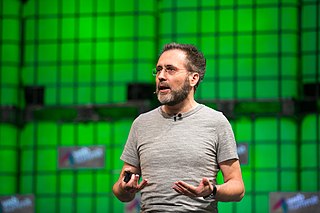Related Research Articles

In computing, a server is a piece of computer hardware or software that provides functionality for other programs or devices, called "clients". This architecture is called the client–server model. Servers can provide various functionalities, often called "services", such as sharing data or resources among multiple clients or performing computations for a client. A single server can serve multiple clients, and a single client can use multiple servers. A client process may run on the same device or may connect over a network to a server on a different device. Typical servers are database servers, file servers, mail servers, print servers, web servers, game servers, and application servers.

ATX is a motherboard and power supply configuration specification, patented by David Dent in 1995 at Intel, to improve on previous de facto standards like the AT design. It was the first major change in desktop computer enclosure, motherboard and power supply design in many years, improving standardization and interchangeability of parts. The specification defines the dimensions; the mounting points; the I/O panel; and the power and connector interfaces among a computer case, a motherboard, and a power supply.

Energy Star is a program run by the U.S. Environmental Protection Agency (EPA) and U.S. Department of Energy (DOE) that promotes energy efficiency. The program provides information on the energy consumption of products and devices using different standardized methods. The Energy Star label is found on more than 75 different certified product categories, homes, commercial buildings, and industrial plants. In the United States, the Energy Star label is also shown on the Energy Guide appliance label of qualifying products.

A data center or data centre is a building, a dedicated space within a building, or a group of buildings used to house computer systems and associated components, such as telecommunications and storage systems.
Green computing, green IT, or ICT sustainability, is the study and practice of environmentally sustainable computing or IT.

A low-energy house is characterized by an energy-efficient design and technical features which enable it to provide high living standards and comfort with low energy consumption and carbon emissions. Traditional heating and active cooling systems are absent, or their use is secondary. Low-energy buildings may be viewed as examples of sustainable architecture. Low-energy houses often have active and passive solar building design and components, which reduce the house's energy consumption and minimally impact the resident's lifestyle. Throughout the world, companies and non-profit organizations provide guidelines and issue certifications to guarantee the energy performance of buildings and their processes and materials. Certifications include passive house, BBC - Bâtiment Basse Consommation - Effinergie (France), zero-carbon house (UK), and Minergie (Switzerland).

The fuel economy of an automobile relates to the distance traveled by a vehicle and the amount of fuel consumed. Consumption can be expressed in terms of the volume of fuel to travel a distance, or the distance traveled per unit volume of fuel consumed. Since fuel consumption of vehicles is a significant factor in air pollution, and since the importation of motor fuel can be a large part of a nation's foreign trade, many countries impose requirements for fuel economy. Different methods are used to approximate the actual performance of the vehicle. The energy in fuel is required to overcome various losses encountered while propelling the vehicle, and in providing power to vehicle systems such as ignition or air conditioning. Various strategies can be employed to reduce losses at each of the conversions between the chemical energy in the fuel and the kinetic energy of the vehicle. Driver behavior can affect fuel economy; maneuvers such as sudden acceleration and heavy braking waste energy.

Urs Hölzle is a Swiss software engineer and technology executive. As Google's eighth employee and its first VP of Engineering, he has shaped much of Google's development processes and infrastructure, as well as its engineering culture. His most notable contributions include leading the development of fundamental cloud infrastructure such as energy-efficient data centers, distributed compute and storage systems, and software-defined networking. Until July 2023, he was the Senior Vice President of Technical Infrastructure and Google Fellow at Google. In July 2023, he transitioned to being a Google Fellow only.

A power supply unit (PSU) converts mains AC to low-voltage regulated DC power for the internal components of a computer. Modern personal computers universally use switched-mode power supplies. Some power supplies have a manual switch for selecting input voltage, while others automatically adapt to the main voltage.
Efficient energy use, sometimes simply called energy efficiency, is the process of reducing the amount of energy required to provide products and services. For example, insulating a building allows it to use less heating and cooling energy to achieve and maintain a thermal comfort. Installing light-emitting diode bulbs, fluorescent lighting, or natural skylight windows reduces the amount of energy required to attain the same level of illumination compared to using traditional incandescent light bulbs. Improvements in energy efficiency are generally achieved by adopting a more efficient technology or production process or by application of commonly accepted methods to reduce energy losses.

80 Plus is a voluntary certification program launched in 2004, intended to promote efficient energy use in computer power supply units (PSUs).
In computing, performance per watt is a measure of the energy efficiency of a particular computer architecture or computer hardware. Literally, it measures the rate of computation that can be delivered by a computer for every watt of power consumed. This rate is typically measured by performance on the LINPACK benchmark when trying to compare between computing systems: an example using this is the Green500 list of supercomputers. Performance per watt has been suggested to be a more sustainable measure of computing than Moore’s Law.

Energy in Finland describes energy and electricity production, consumption and import in Finland. Energy policy of Finland describes the politics of Finland related to energy. Electricity sector in Finland is the main article of electricity in Finland.
Power usage effectiveness (PUE) is a ratio that describes how efficiently a computer data center uses energy; specifically, how much energy is used by the computing equipment.
IT energy management or Green IT is the analysis and management of energy demand within the Information Technology department in any organization. IT energy demand accounts for approximately 2% of global CO2 emissions, approximately the same level as aviation, and represents over 10% of all the global energy consumption. IT can account for 25% of a modern office building's energy cost.
Premium efficiency, when used in reference to specific types of Electric Motors, is a class of motor efficiency.

In computer networking, Energy-Efficient Ethernet (EEE) is a set of enhancements to twisted-pair, twinaxial, backplane, and optical fiber Ethernet physical-layer variants that reduce power consumption during periods of low data activity. The intention is to reduce power consumption by 50% or more, while retaining full compatibility with existing equipment.
Plug load is the energy used by products that are powered by means of an ordinary AC plug. This term generally excludes building energy that is attributed to major end uses
The House Energy Rating (HER) or House Energy Rating Scheme (HERS) are worldwide standard measures of comparison by which one can evaluate the energy efficiency of a new or an existing building. The comparison is generally done for energy requirements for heating and cooling of indoor space. The energy is the main criterion considered by any international building energy rating scheme but there are some other important factors such as production of greenhouse gases emission, indoor environment quality, cost efficiency and thermal comfort, which are considered by some schemes. Basically, the energy rating of a residential building provides detailed information on the energy consumption and the relative energy efficiency of the building. Hence, HERs inform consumers about the relative energy efficiency of homes and encourage them to use this information in making their house purchase decision.

A green data center, or sustainable data center, is a service facility which utilizes energy-efficient technologies. They do not contain obsolete systems, and take advantage of newer, more efficient technologies.
References
- ↑ Sustainable Business Oregon (2010-07-27). "Study: IT sector cuts CO2 emissions by 32M metric tons". Portland Business Journal . Retrieved 2010-07-27.
{{cite web}}:|author=has generic name (help) - ↑ This reduction in emissions was calculated based on IDC projections of desktop and server volumes in the years 2007-2011, using a baseline of 295 kWh/year energy consumption for a typical desktop in the first half of 2007, and assuming market penetration of 60% of desktop units shipped in 2010 being Energy Star, 25% meeting the 85% PSU efficiency standard, 10% meeting the 88% standard, and 5% meeting the 90% standard; it also assumed that 80% of desktop PCs shipped in 2010 use power management features. Under these assumptions, total power consumption for PCs shipped in 2010 was reduced by over 50%, for a total savings of 62 billion kWh in 2010, worth over $5.5 billion (at an average cost of $0.0885/kWh ). Note: the total savings in 2010 is based on power consumed by units shipped in 2007, 2008, 2009, and 2010.
- 1 2 Based on IDC projections of desktop and server units shipped, a baseline of typical desktop and server power consumption in the first half of 2007, and an average cost of $0.0885/KW.
- ↑ Call to action video at YouTube